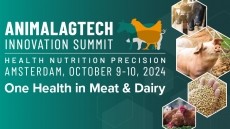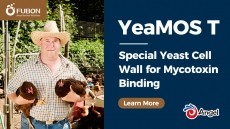Crude glycerin as substitute for antibiotics in cattle diets

A team of researchers from São Paulo State University and the Federal University of Viçosa in Brazil examined the use of crude glycerin (CG) and virginiamycin (VM) in the diets of feedlot cattle. The group published its work in the journal of Animal Feed Science and Technology.
“We hypothesize that CG (substrate promoter of lactate-utilizer bacteria) could replace VM (inhibitor of gram-positive lactate-producing bacteria) without impairing rumen fermentation or that combining VM and CG would increment the positive effects on fermentation and promote the growth of bacteria that metabolize lactate.
“The objective of this study was to evaluate the effect of combining VM (0 or 25 mg/kg DM) and CG (0 or 100 g/kg DM) on fermentation and microbial population of feedlot Nellore cattle.”
The researchers found that although adding either additive did not change the amount of fibrolityc bacteria found, total protozoa counts fell when VM was added to the diet. Adding crude glycerin to the diet, however, tended to boost rumen fermentation.
“Crude glycerin had positive effects on rumen fermentation products and can replace virginiamycin with increments of Megasphaera elsdenii abundance,” they said. “However, combining virginiamycin and glycerin does not affect positively rumen fermentation and the growth of bacteria that metabolize lactate.”
Why crude glycerine and virginiamycin?
Feedlot diets for cattle tend to have high starch levels, which can alter the accumulation of volatile fatty acids (VFA) and lactate, the researchers said. The buildup of VFA and lactate also may negatively change the metabolic activity of rumen microbiota.
Management strategies that have been used to alter rumen microbial levels to improve cattle performance and reduce the chance of acidosis include feeding management, adding dietary buffers, feeding antibiotics like virginiamycin, and the use of direct fed microbes, they said.
Using antibiotics in cattle diets at sub-therapeutic levels also has been found to act as a growth promoter as they can prevent the growth of gram-positive, lactate-producing bacteria and boost both average daily gain and the gain to feed ratio, noted the authors.
However, there has been an increasing concern about the use of antibiotics in animal production and several countries have banned or restricted their use in animal feed, they said.
“Another strategy to prevent or attenuate excessive lactate production could be increasing the availability of substrate, such as crude glycerol, to lactate-utilizing bacteria (e.g, Megasphaera elsdenii)."
Glycerol may support the growth of Megasphaera elsdenii and Selenomonas ruminantium in the rumen, they said. Glycerol also can be absorbed through the rumen wall and improve glucose circulation.
“Crude glycerin can replace cereal grains with levels up to 100 g/kg DM of feedlot diets of beef cattle without detrimental effects on performance,” the researchers said. “And it potentially enhances unsaturated fatty acid deposition on meat.”
Methods and materials
In the feeding trial, eight cannulated bulls were given one of four diets for a period of 21 days before being rotated to another of the trial diets, the researchers said. The periods included 14 days of diet adaptation and 7 days for data collection.
The four diets included a diet without virginiamycin or crude glycerin, a diet with virginiamycin at 25 mg/kg DM (VM+), a diet with crude glycerin at 100 g/kg DM (CG+) and a diet with both virginiamycin and crude glycerin, they said. The basal diet included sugarcane bagasse and concentrates.
Samples of the diets and orts were collected to establish dry matter intake (DMI) and fecal samples were taken, they said. Apparent total tract digestibility of nutrients was calculated and neutral detergent fiber (NFD) was analyzed.
Ruminal samples were collected before feeding and at 3, 6, 12 and 18h post feeding, to check pH value, amounts of NH3-N (Ammoniacal nitrogen) and VFA, they said. Samples also were checked for the amount of bacteria and protozoa.
Results
No interaction was noted between CG and VM regarding feed intake or total tract digestibility, the researchers said. Animals getting the diet with GC had greater dry matter intake, while total tract digestibility tended to be consistent for all diets.
“There is no interaction (P ≥ 0.10) for CG × VM, CG× time, VM× time and VM× CG× time on pH, VFA and NH3-N,” they said. “The VFA, mM concentration and pH was similar among treatments.”
However, the acetate and acetate to propionate ratio fell more in diets with CG than in the control diet, and the propionate, butyrate and valerate proportions were higher in diets supplemented with CG than in the control, they said.
The proportion of propionate increased in diets with CG, regardless of VM and the NH3-N concentration was consistent among all diets, they said.
The amounts of Megasphaera elsdenii doubled in diets with added CG compared to the control, they said. “However, combining virginiamycin and glycerin does not affect positively rumen fermentation and growth of bacteria that metabolize lactate."
Neither feed additive altered the amounts of fibrolityc bacteria found nor the protozoa counts, though they tended to decrease when VM was added to the diet, they said.
Source: Animal Feed Science and Technology
DOI: published online ahead of print: doi.org/10.1016/j.anifeedsci.2018.05.007
Title: Changes in ruminal fermentation and microbial population of feedlot Nellore cattle fed crude glycerin and virginiamycin
Authors: Pablo Castagnino, Erick Dallantonia, Giovani Fiorentini, Elias San Vito, Juliana Messana, Laís Lima, Tiago Simioni, Telma Berchielli


















